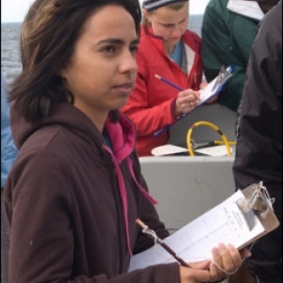Eight students will be presenting the summer work at the Ocean Sciences Meeting in March 2022!
Laura Almodovar Acevedo, University of Puerto Rico
Class Year:
2009Mentor:
Lora Harris, Ph.D.Project Title:
Sediment Dynamics at the Jug Bay Wetland Sanctuary, Maryland, USA
Abstract:
Freshwater tidal marshes are transitional ecosystems between fresh and oligohaline waters. Stability of these ecosystems depends on a balance between marsh platform accretion rates and sea level rise. The capacity of a marsh to maintain this balance is strongly influenced by sediment deposition and capture, which in turn is influenced by the marsh vegetation. In a spatterdock dominated low-marsh at the Jug Bay Wetland Sanctuary, Maryland, we observed sediment dynamics over a tidal cycle with an emphasis on water column suspended sediment inputs, measurements of captured sediment on rinsed spatterdock leaves and stems, and sediment deposition. We took into consideration the distance from the water and sediment source and the variability of inundation depths and timing. We found that plants closer to the water source captured more sediment. Plant height was another determining factor, where leaves of taller plants were not submersed and had less surface area available to capture sediment. Sediment traps that were underwater for longer time periods captured exponentially more sediment. In addition to concluding that tidal inundation and plant morphology interact to influence sediment capture, we documented changes in sediment concentrations between flood and ebb tides that may indicate sediment loss and erosion.
Location:
Chesapeake Biological LaboratoryPresentations:
Almodovar, L.*, and L. Harris. 2009. Sediment dynamics at Jug Bay wetland sanctuary, Maryland . Coastal and Estuarine Research Federation 20th Biennial Conference, Portland, Oregon .




